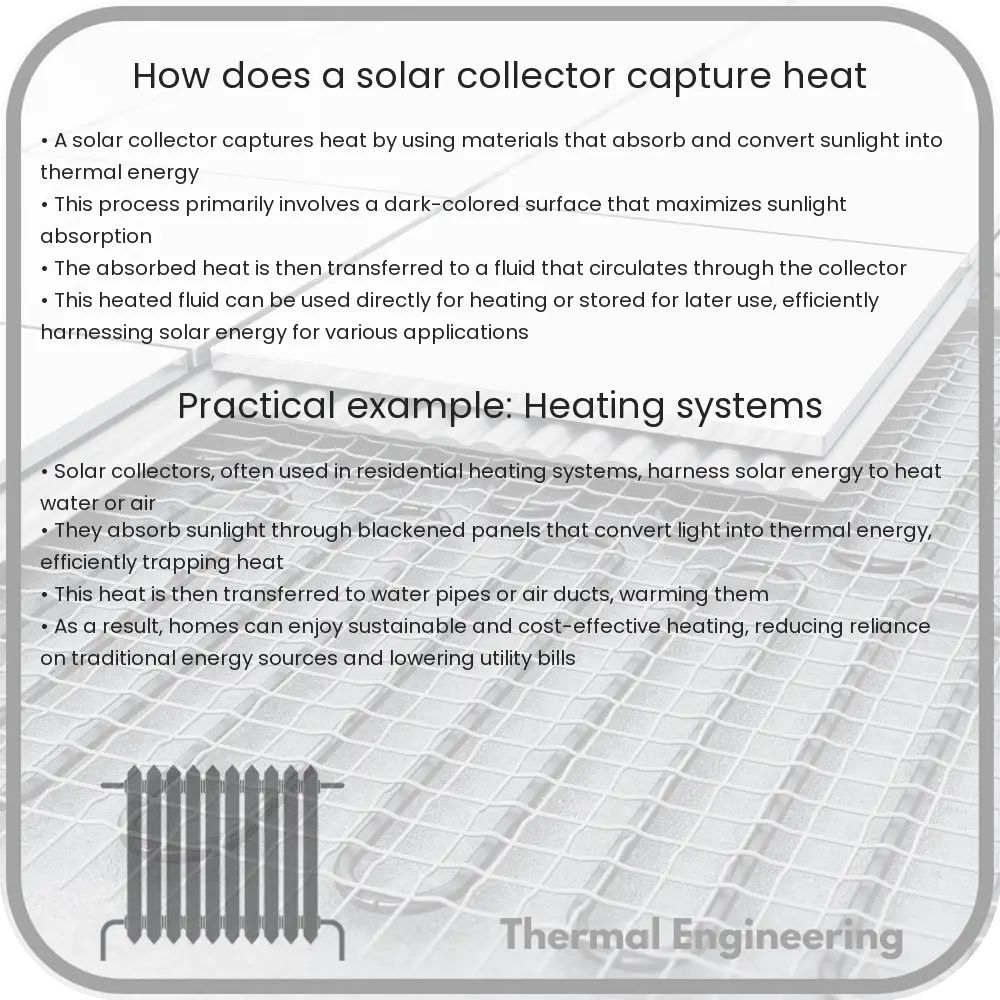Learn how solar collectors capture and convert solar energy into heat, and their role in sustainable energy solutions.

Understanding How a Solar Collector Captures Heat
Solar collectors are devices used to absorb solar radiation and convert it into usable heat energy. This technology plays a vital role in solar thermal systems, where heat is used directly, or in solar power generation systems that convert heat into electricity. The functioning of solar collectors involves a few key components and takes advantage of basic principles of heat transfer.
Key Components of a Solar Collector
- Transparent Cover: This top layer allows solar energy to enter the collector while minimizing heat loss to the environment.
- Absorber Plate: Typically a dark-colored plate that absorbs solar energy and converts it to heat.
- Heat Transfer Fluid: Fluid, often water or an antifreeze solution, that flows through the collector to absorb the heat from the absorber plate.
- Insulation Layer: Minimizes heat loss from the back and sides of the collector to ensure efficiency.
Operational Principles
To understand how a solar collector captures heat, it’s essential to look at the process step-by-step:
- Solar Radiation Absorption: The transparent cover allows sunlight to pass through and reach the absorber plate, which is designed to absorb maximum solar energy.
- Heat Conversion: Once the absorber plate captures the sunlight, it converts the solar energy into heat. This is primarily due to the dark color of the plate, which enhances its ability to absorb and retain heat.
- Heat Transfer: The heat from the absorber plate is transferred to the heat transfer fluid. This fluid circulates through channels or tubes in the collector, picking up heat as it goes.
- Heat Retention: Insulation materials around the sides and back of the collector minimize heat loss to the environment, ensuring that most of the collected heat remains within the collector.
Energy Conversion Efficiency
The efficiency of a solar collector is influenced by several factors:
- Material Properties: The ability of the absorber plate material to absorb and transmit heat efficiently directly affects performance.
- Fluid Circulation Speed: The rate at which the heat transfer fluid moves through the collector can impact how much heat is absorbed versus how much is lost back to the environment.
- Insulation Quality: Effective insulation reduces unwanted heat loss, increasing the overall efficiency of the solar collector.
- Angle of Incidence: The angle at which sunlight strikes the collector affects how much solar energy can be absorbed. Optimal angling toward the sun directly influences efficiency.
Real-World Applications
Solar collectors are utilized in various applications, including:
- Domestic Hot Water Systems: Heating water for household use.
- Space Heating: Providing heat in residential and commercial buildings.
- Solar Thermal Power Plants: Generating electricity by converting solar heat into mechanical energy and then into electrical energy.
- Industrial Processes: Supplying heat for industrial purposes, such as drying, cooking, or pasteurization.
The ability for solar collectors to capture and utilize heat from the sun not only helps reduce reliance on fossil fuels but also promotes a cleaner, more sustainable energy future. As technology advances, the efficiency and applications of solar collectors continue to expand, offering promising prospects in both residential and industrial sectors.